
|
Just get up there and do it!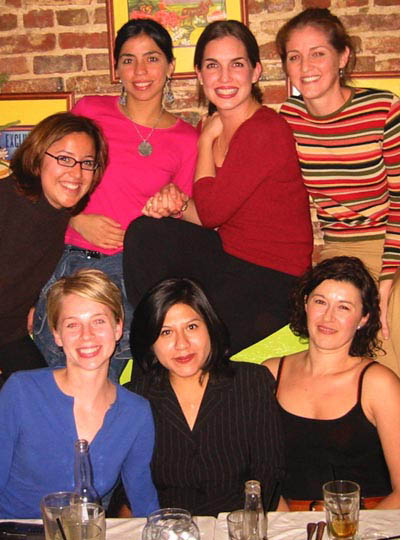 (Reprint from Monday December 3, 2001) So you've just learned all four coplas of Sevillanas. Are you just going to wait for your teacher make you perform in a student recital? Some dances, Sevillanas for example, work especialy well in a festive, informal setting such as last night's crowd at Café Citrón (202-530-8844). Pictured clockwise starting from upper right are Florencia Pettigrew, Veronika Amaya, Janna Lipman, Marcela Salazar, Alexa Miranda and Jamie. It took some cheering from a very enthusiastic crowd, but eventually some of them gave in and joined dancer Micaela Moreno onstage.There were others who also got up and danced some of whom explained to me afterwards that this was their public "debut" of Sevillanas. Here are some tips for beginners (not to imply that anyone needed these last night):
Whenever you have the chance to dance Sevillanas, just get up there and do it! Cafe Citrón has flamenco shows on Mondays at around 8pm and 9pm. It's located at 1343 Connecticut near Dupont Circle. Ballet Flamenco José Porcel coming to George Mason University's Center for the Arts November 19 & 20, 2005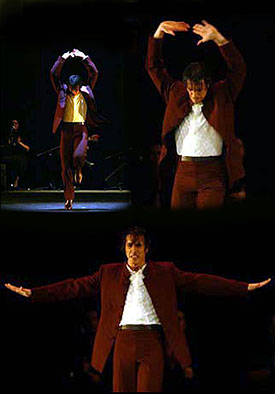 October 30, 2005 While the origins of flamenco are still uncertain, it is probable that flamenco singing and dancing originated in Spain’s Andalucia region toward the fifteenth century, during the Gypsies' encounter with the inhabitants of southern Spain. José Porcel, born in Seville, began dancing these Andalucian folkloric dances and flamenco in cultural centers in Valencia at the age of thirteen. Now, this celebrated artist brings his company – Ballet Flamenco José Porcel – to George Mason’s Center for the Arts for two performances only – celebrating the cultural phenomenon that is flamenco, Saturday, November 19 at 8:00 p.m. and Sunday, November 20 at 2PM. Both performances are family friendly – children 12 and under are half price – and both feature artistic discussions beginning 45-minutes prior to the curtain on the hall’s Grand Tier. This performance showcases a fascinating and continually evolving art form. Originally a rhythmic accentuation for singing, flamenco has been enriched over time by individual interpretations: the source of a vast repertoire of cuadros (portraits) illustrating the intense and passionate nature of the region. While it is extremely difficult to trace the origin of wandering populations who, when they arrived in the region of Andalucia, bore a cultural mix of Arabic-Egyptian, Jewish, and Indian (which is obvious, for example, in the gentle and voluptuous movements of the dancers' bodies and arms) influences. The nearly endless cultural permutations have blended to create the solemnity of soleares, the contagious festivity of sevillanas, and the traditional celebratory images portrayed in alegrías. Only in the past century has flamenco developed as a "theatrical performance," involving stylistic experimentation, refinement of expression, and technical codification indissolubly bound to the Gypsy spirit. Program, November 19 & 20, 2005 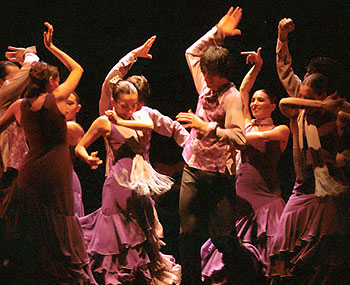 PART TWO: TIENTO / TARANTO (JOSÉ PORCEL AND FEMALE DANCER) Celebrating the romance and love between man and woman in classic flamenco style. SEGUIRILLA (MALE DANCERS) The male dancers demonstrate the flavor and passion of flamenco song. ALEGRÍAS (FEMALE DANCERS) A flowing, sensual dance. SOLEA POR BULERÍAS (JOSÉ PORCEL) In the classic flamenco tradition, José Porcel is featured in a vivid improvisation. TANGOS (ENTIRE COMPANY) The entire company performs this final work in the classic flamenco style. Tickets for BALLET FLAMENCO JOSE PORCEL are $42, $34 and $21. Charge by phone at 888-945-2468 or visit www.tickets.com The Center for the Arts complex is located on the Fairfax campus of George Mason University at the intersection of Braddock Road and Route 123. Paid parking is located in the deck adjacent to the mainstage Concert Hall and FREE parking is located in university lot K. Visit www.gmu.edu/cfa. Don't forget to enter the coupon code DCFL for a 10% discount. So you want to play for dance classes?Reprint from Monday September 1, 2003 September's almost here which means that most of the dance teachers are about to start their Fall classes. This is usually a good time for aspiring flamenco dance accompanists to get started playing for classes. 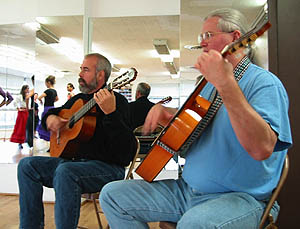 Why? Coming in the middle of the semester might be a little awkward: the dance students have already learned a good chunk of choreography or technique exercises to a set piece of music. Struggling to figure out what to play on your first day while the dance class waits for you is not a good way to get started. I was planning to write a longer article about dance accompaniment. But when I asked a few local dance teachers for some quotes on this topic, they sent me a lot more than that. Oh well, it makes my job easier. My thanks to Natalia Monteleon, Nancy Heller, Aleksey el Rusito and Anna Rubio. (I've included their telephone numbers in case you want to call them about playing for dance classes.) Natalia Monteleon (301-617-0694), who teaches at her home studio in Laurel, Maryland writes: "The first and foremost -- for novitiates. You can't be a complete day #1 beginner and play for dancers. You must have some background first, and it is best if you are studying with a professional flamenco guitar teacher, who can guide you as you proceed. If a beginner guitarist would like to learn to accompany, it's fine to start with a beginner level dance class. Don't try a midlevel or advanced class unless there is a professional level guitarist playing, and then be content to play '2nd fiddle'and take his/her advice. Be prepared to play rhythm and chords. Dance classes don't need fancy falsetas, and in fact these can be more of a hindrance than a help. Besides - the guitarist will learn a lot by playing rhythm and watching and listening to the dancers for each tempo change. Falsetas come later. 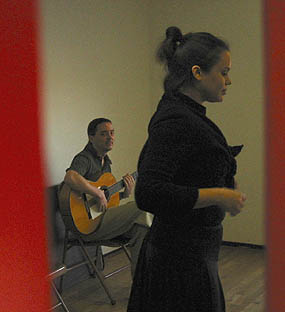 What a dance teacher hates most is for a new guitarist to come in full of things they learned by listening to Paco de Lucía, and then try to play them for class. You may have the technique to play them for your own gratification, but this is not the way to learn to accompany. You can be sure that Paco de Lucía didn't start this way! Remember that the teachers' primary responsibility is to teach the dancers. She/he may be patient and willing to stop every once in awhile when things get too far out of compás. This may be the students' problem, or it may be the guitarist struggling to get it right. Trust the teacher - they are trying to be a conductor and keep everyone together. Once the guitarist is no longer a complete beginner, it is OK to be involved in more advanced classes. Go to your guitar teacher, tell him what the class is working on, they can give you good ideas of falsetas to plug in. But don't be upset if the falseta does or does not go with the series of steps the dancers have. Working on fitting these things together is part of the process. Payment -- well it's like this... Last - Playing flamenco means playing for dance and cante. One might enjoy playing solo guitar and that's fine. However in my book, a flamenco guitarist is one who knows how to accompany, knows the llamadas, desplantes, knows the mood of the palo, is familiar with a good deal of the cante repertoire. Most flamencos will tell you that the most gratifying feeling is playing in a group with dancer, guitar, palmas, and cante (when possible). When it all comes together - the feeling is euphoric. So - please DO make the effort to learn - it's great!" Next we have Nancy Heller, who teaches in Pennsylvania: "[To the Beginning Accompanist]
[To the Dance Teacher Working with A Beginning Accompanist:]
Aleksey el Rusito: "The 'unsatisfiable' wishes of flamenco dance teachers must feel like quite a mystery to the beginner flamenco guitarists. And, probably, often the information received from a guitar teacher will feel like it contradicts what is taught in a dance class. There is a lot to feel in these mysteries and conflicts and, hopefully, the student-guitarist will be able to channel all of those feelings into creative energy... 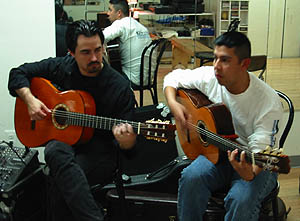 One thing to always remember is that a flamenco dancer (if he/she is good) has a lot to offer to a beginner flamenco musician. Yes, you can offer something to a dance teacher, too, but before you have to learn a lot about dance. A good test to check whether you have entered the stage when you are contributing to the class is when the teacher does not look at you when he/she is counting and when he/she does not stop you to explain each and every step and how it fits into the music before having you accompany the students doing the same step. A flamenco dance teacher does want a guitarist in his/her class (yes)! It adds to the learning experience of the students, provides flexibility when teaching and practicing steps, inspires the teacher and the students, and the list continues. But in the beginning, the dance teacher is doing you a favor by letting you play in the class. So, do not get offended if the teacher tells you to stop playing and 'just listen,' asks you to clap, or even if he/she puts on a CD and has you and the dance students listen or practice to a recorded music. It's ok if you do not know something, and if one of the above-mentioned things happens to you, it most likely means that you need to concentrate on learning something you do not know yet. The notion of compás is of extreme importance. Unfortunately many guitar teachers do not emphasize it enough. In fact, you can probably get away with not playing in compás in a flamenco-illiterate crowd. However, it would be much harder to accomplish if you are accompanying a dancer. Compás will be the foundation, on which you and the dancer (and a singer if you are lucky to have one) will build your beautiful palace for 'el duende.' That is why, one of the main skills you are acquiring in a flamenco dance class is how to support the dancer rhythmically. Supporting the dancer melodically, whatever that entails, is a much harder task and can be learned only with a good and experienced dancer (of which there are not as many as one may think). It is important to understand that acquiring the skill of the melodic support cannot and will not be successful without having the compás down first. Respect is of utmost importance. Hopefully, both you and the teacher will show all due respect to each other and, what is of equal if not greater importance, to the art of flamenco. Most of the respect laws and regulations are intuitive. However, remember that in that class you are a student, and the dance teacher is your teacher, too. Therefore, sometimes you will simply have to keep your hard feelings to yourself or discuss them with the teacher (at your own risk :) ) one-on-one after the class." Finally, we have Anna Rubio who teaches in Philadelphia (215-218-7269) "I don't think of a guitarist as a Flamenco Guitarist unless they can accompany (in my humble opinion). What defines flamenco is the connection of the artists to the compás, as I have said before; flamenco is an individual artform, but it is a group experience. And sitting in class playing for dancers is the only way to learn, first sitting next to a more experienced player and then by yourself. My husband plays for all my classes and what I notice invariably happens is; the student guitarists spend all their time looking at his hands instead of watching how he responds to me teaching or the students dancing. Fortunately for them, Tito is a wonderful teacher as well as an amazing guitarist, and he always works hard to show them and tell them WHY he is doing what he is doing and trying to get them to look at ME and not his hands. I can understand that when you are studying guitar and spending hours and hours by yourself playing it is easy to lose sight of the Big Picture..the interplay between the artists, not just the beautiful falseta! Because of the way Tito teaches the guitar students at the same time as accompanying my classes, it has happened that guitarists want to sit with him as a way of having a free class. Our policy is that these people have to pay to sit in my class with him (and they get their money's worth). Any student of his who sits in my class doesn't pay, Tito decides whether they can play or just do palmas. BUT I always pay any guitarist who plays for my class without Tito, even if they are struggling through the class, because they are doing a job. I believe this job deserves respect, just as my job deserves respect." There you have it. These are just four views on the topic, but it's enough to give you some idea of what the dance teachers generally have in mind when working with live dance accompaniment in class. So if you think you're ready to get started, contact one of the dance teachers listed in my teachers page and find out when classes begin. Good luck! Previously published articles on this topic, from the guitarist's point of view: Practice outside of classReprint from Monday August 12, 2002 Working as a flamenco guitarist in DC since 1991, I've been to more flamenco dance classes than just about anyone. So while I sit there class after class after class, accompanying with my guitar, I do notice lots of things including certain stereotypes of students. As fun as it would be, I'm not about to go into all the kinds of students you find in a typical class, but I will go into picking out the ones who don't practice. You know who you are. Week after week, you come to class knowing full well that you didn't practice outside of class. And you think that the teacher doesn't notice. If it's a large class, that may be true. But we guitarists know a fair amount about dancing since we go to class all the time so we do notice, and we do talk to the dance teachers. So there's no getting away with skipping practice! :) 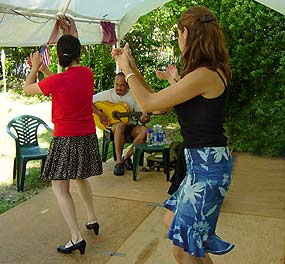
In all fairness, there are those that take dance class as an escape from their day-to-day life and may take class purely for pleasure...and that's fine. But for the rest of you, in order to make the most of your technical progress, you must practice outside of class (even if it's only ten minutes a day). We all have our own peculiar ways of absorbing information. Very few of us have the ability to watch the teacher demonstrating a step once and immediately duplicate it exactly. Some of us learn the sequence of steps and then fit it into the compás. Some internalize the "sound" of the steps and then learn exactly which foot makes what sound. Then we have arms, head, shoulders, body lines, angles etc etc. Whatever it is you do, the teacher can only give you so much time during class to cater to your individual style of learning. When you do get the individual attention, listen carefully and remember what the teacher is saying. Whatever the teacher says, assume that he/she is also adding, "...when you practice outside of class." Practice feels like work, and it is, but that does not mean it can't be enjoyable. One way to do this is to team up with some classmates. Help and encourage each other. I met up with a couple of dance students during their practice meeting last Saturday. I put each of them on the spot by having them dance individually while the others provided palmas. Afterwards these were some of their comments: "[Dancing one at a time] really let's you see what your mistake is. Because otherwise it's so easy to [hide] behind the other dancers and then you really don't know what you're doing [wrong]..." "When I get home, I practice with a metronome. But it's so much more helpful to have the guitar there. You really feel like your connecting with the guitar..." "When we do this once a week with friends, it's great. And dancing individually honestly does help. It makes me [realize] 'I'm off of this beat' and not just follow somebody else. And during the week, now that I know where my weaknesses are, I know what to practice on my own." What you will need to setup your practice group:
|
